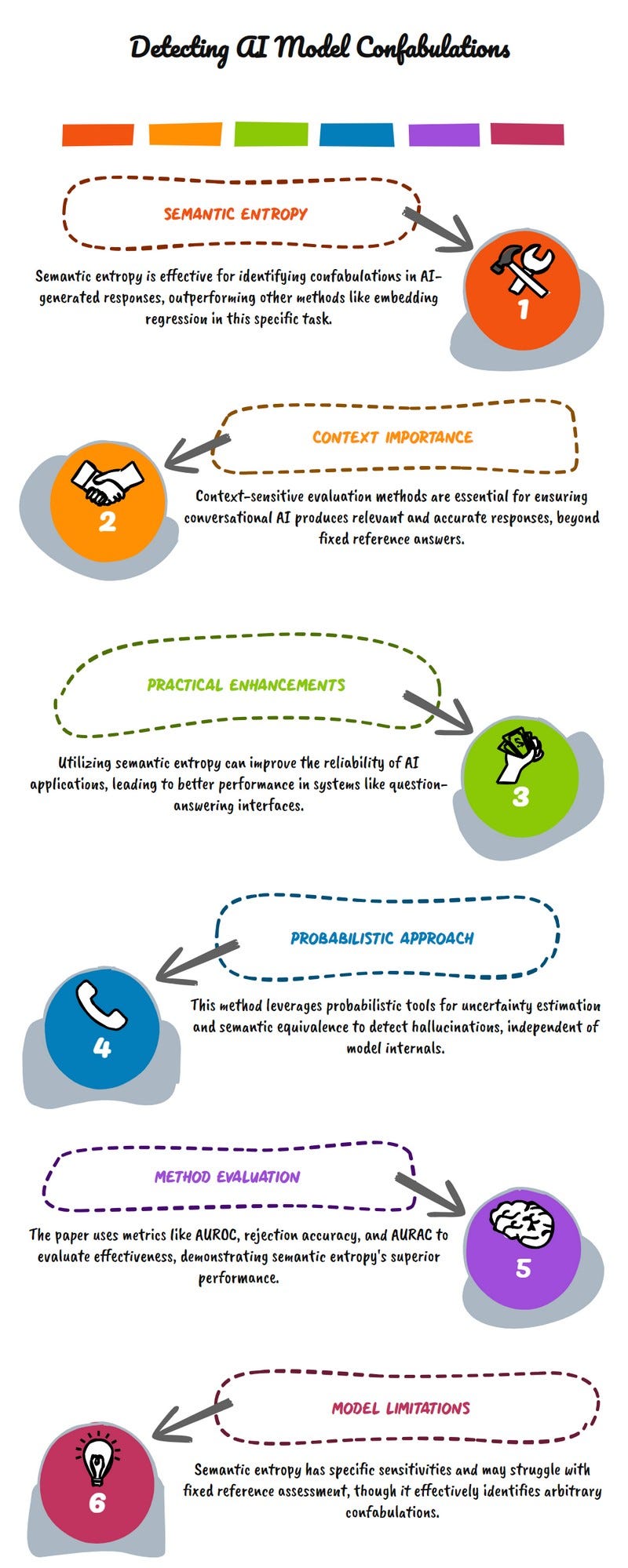Detecting hallucinations in large language models using semantic entropy
Series on Methods for Quantifying Uncertainty in LLM Outputs
This is a non-technical explanation of the original paper - Detecting hallucinations in large language models using semantic entropy
Abstract
The paper discusses the effectiveness of semantic entropy in detecting confabulations, which are a significant type of error in model generations.
It compares semantic entropy with other methods, highlighting that while some methods can identify various errors, semantic entropy is superior in detecting confabulations specifically.
The study emphasizes the importance of context in evaluating model responses, noting that fixed reference answers may not adequately capture the flexibility needed in conversational AI.
Overall, the findings suggest that semantic entropy provides a reliable measure for assessing the correctness of model outputs in various contexts.
Practical Implications
The use of semantic entropy can enhance the detection of confabulations in AI-generated responses, leading to more reliable outputs in applications like question-answering systems.
Understanding the limitations of existing methods, such as embedding regression, can guide researchers and developers in selecting appropriate techniques for training and evaluating language models.
The findings emphasize the need for context-sensitive evaluation methods, which can improve the performance of conversational AI by ensuring that responses are relevant and accurate in various situations.
The paper suggests that larger models may yield better performance in generating accurate answers, which can inform decisions on model selection and deployment in real-world applications.
Validating model outputs against human correctness evaluations can lead to more robust systems, ensuring that AI tools align better with user expectations and real-world accuracy.
Methodology:
The paper introduces semantic entropy as a strategy for overcoming confabulation in language models. This method builds on probabilistic tools for uncertainty estimation and can be applied directly to any large language model (LLM) without requiring modifications to the architecture.
This variant can be applied even when the predicted probabilities for the generations are not available, making it useful when access to the internals of the model is limited.
The paper employs a probabilistic approach that accounts for semantic equivalence to detect hallucinations caused by a lack of LLM knowledge.
The methods are evaluated using three main metrics: AUROC (Area Under the Receiver Operating Characteristic curve), rejection accuracy, and AURAC (Area Under the Rejection Accuracy Curve). These metrics are grounded in automated factuality estimation relative to reference answers provided by the datasets used.
The paper compares semantic entropy with the P(True) method, where the model samples multiple answers and is then prompted to determine the truthfulness of the highest probability answer. This method is enhanced with a few-shot prompt using ground-truth training labels.
Limitations:
The paper notes that semantic entropy can be overly sensitive in some contexts, leading to erroneous high entropy values. This is particularly evident when the clustering method distinguishes between answers that provide a precise date versus those that only provide a year, which may be irrelevant in certain contexts.
Evaluating against fixed reference answers has shortcomings, as it does not capture the open-ended flexibility required for conversational deployments of LLMs. This highlights the importance of context and judgment in clustering, especially in subtle cases.
Semantic entropy is not effective for detecting consistent errors learned from the training data. It is primarily suited for identifying confabulations, which are arbitrary incorrectness.
While semantic entropy outperforms baselines across all model sizes, the P(True) method seems to improve with model size. This suggests that P(True) might become more competitive for very capable models in settings that the model understands well, although these are not the most critical cases for uncertainty.
Although the paper suggests that semantic entropy can be adapted to other problems like abstractive summarization, it does not provide detailed methodologies for these adaptations, leaving room for further research and development.
Conclusion:
The paper concludes that semantic entropy is highly effective at detecting confabulations in model-generated answers. It outperforms baseline methods like embedding regression, which suggests that confabulations are a principal category of errors in actual generations.
The importance of context and judgment in clustering is highlighted, especially in subtle cases. The paper points out the limitations of evaluating against fixed reference answers, which do not capture the open-ended flexibility of conversational deployments of LLMs.
Although semantic entropy outperforms baselines across all model sizes, the P(True) method improves with model size. This indicates that P(True) might become more competitive for very capable models in well-understood settings, though these are not the most critical cases for uncertainty.
While semantic entropy is effective at detecting confabulations, it is not suited for identifying consistent errors learned from training data. This limitation suggests that further research is needed to address other types of errors.
The paper suggests that the methods discussed could be adapted to other problems like abstractive summarization, although detailed methodologies for these adaptations are not provided.
Paper Infographic


